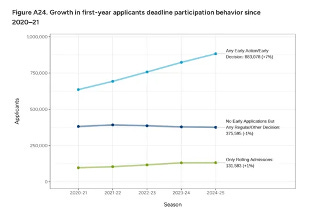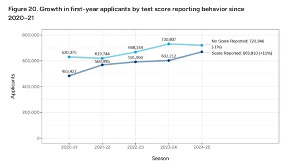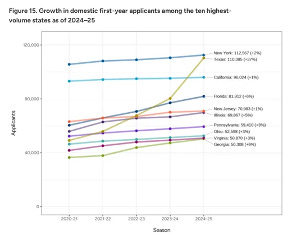[2025 U.S. College Admissions Trends] Chinese Applicants Rise 6%, Test Scores Return, Early Applications Surge
Charting New Territories: Emerging Trends and Strategic Insights for U.S. College Admissions
Recent data from the Common App for the 2024–2025 application season reveals significant shifts in application patterns that are important for U.S. college admissions.
The report, compiled as of March 1, offers a comprehensive look at trends among both domestic and international applicants—highlighting notable increases in early applications, standardized test submissions, and a resurgence of Chinese applicants. These insights can inform admissions strategies as competition intensifies and diverse applicant profiles emerge.
Key Application Statistics
Overall Growth:
Total number of applicants reached approximately 1.39 million—a 4% increase over previous seasons.
Nearly 8.54 million applications were submitted, reflecting a 6% growth, with each new student applying to an average of 6.14 schools.
Shifts in Application Timing:
Early applications surged by 7%, reaching 883,078 submissions.
In contrast, regular decision (RD) applications slightly declined by 1% (375,595 submissions).
Institutions continue to see higher early admission acceptance rates, prompting schools like the University of Chicago and the University of Southern California’s Marshall School of Business to add additional early rounds.
Standardized Testing Trends:
Submissions of standardized test scores climbed by 11%—with 669,910 applicants including tests in their files.
The rising emphasis on standardized test results is especially evident at highly competitive schools and top-30 ranked institutions, where rigorous score benchmarks are becoming a key differentiator.
International Application Insights
Asian Applicants and the Chinese Resurgence:
Asian application numbers totaled 83,233, with Chinese applicants accounting for over 30% (25,455 submissions) and marking a 6% increase from the previous cycle.
This renewed strength underscores Chinese families’ sustained interest in U.S. undergraduate education as well as a broader trend in international student competition.
Regional Variations:
While international applications overall edged down by 1%, the increase in Asian submissions contrasts sharply with a 17% decline in applications from Africa.
The UC system witnessed a healthy 8.5% growth in international submissions, suggesting that public university options are gaining appeal because of their cost effectiveness and strong educational offerings.
Early Action and Public University Appeal
Early Action Surge:
The early action wave was particularly robust, with a 17% year-on-year increase. Over 3 million early action submissions indicate that applicants are accelerating their decision-making process to enhance their candidacy.
Preliminary data from elite early rounds also suggest that competitive scores—such as TOEFL averages above 110, SAT scores above 1540, and ACT scores above 34—are becoming common benchmarks.
Increasing Interest in Public Institutions:
Public universities experienced a 10% uptick in applications, compared with a modest 2% rise at private institutions.
This trend is likely driven by increasing tuition costs at private colleges and the comparative affordability and strong academic reputations of public institutions.
Implications for Admissions
For U.S. college admissions officials, these trends serve as a signal of evolving applicant behaviors and priorities:
Enhanced Competition and Diverse Profiles:
The resurgence of Chinese applicants and sustained global interest necessitate a holistic review approach that accounts for both academic and extracurricular excellence. Applicants are not only aiming for strong standardized scores but are also building unique, differentiated profiles to stand out in a crowded field.Evaluating Early Action Strategies:
With early submissions increasing sharply, admissions offices should continue to calibrate their early action policies. Clear communication regarding evaluation criteria at early rounds will be essential as more students use this route to gain a competitive edge.Tailored Outreach and Support:
As public universities gain traction, it is worth evaluating recruitment and outreach strategies to ensure alignment with the applicants’ evolving expectations regarding affordability and academic offerings.
Final Thoughts
The 2024–2025 Common App data paints a picture of an increasingly competitive and strategically nuanced application process. For U.S. institutions, these insights underscore the importance of adapting admission strategies to not only manage a higher volume of applications but also to fairly assess the diverse strengths and backgrounds of a globally competitive applicant pool. By staying ahead of these trends, admissions offices can better anticipate challenges and opportunities in the evolving higher education landscape.












